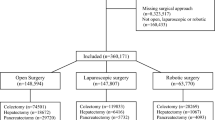Abstract
The objective of this study is to describe changes in rates of types of hysterectomy at a tertiary care community teaching hospital since the introduction of laparoscopic and robotic techniques and to determine the effect of surgeon characteristics on route of hysterectomy. This is a retrospective analysis of types of hysterectomies performed for benign disease during five different years (1989, 1994, 1999, 2004, 2009) at a large community teaching hospital. Hospital discharge data was reviewed to identify all hysterectomies performed during the first six months of each year of the study. Hospital charts were reviewed and patient characteristics, indication for surgery, type of hysterectomy and surgeon characteristics were recorded. Hysterectomies performed for malignancy, suspected malignancy, or postpartum hemorrhage were excluded. Types of hysterectomies included abdominal (AH), vaginal (VH), laparoscopic-assisted vaginal (LAVH), total laparoscopic (TLH), laparoscopic supracervical (LSH) and robotic-assisted (RH). The progressive introduction of newer minimally invasive surgical techniques (LAVH, TLH, LSH, and RH) resulted in an overall reduction in the abdominal hysterectomy rate from 77 to 35.2 % during the time of the study. The majority of abdominal, laparoscopic supracervical and robotic hysterectomies were performed by generalists, while the majority of vaginal, laparoscopic-assisted vaginal and total laparoscopic hysterectomies were performed by fellowship trained subspecialists. Minimally invasive hysterectomy techniques significantly reduced the rate of abdominal hysterectomies. The LSH and RH were the techniques utilized by generalists as their most preferred minimally invasive surgical approaches to hysterectomy.
Similar content being viewed by others
References
Reich H, De Caprio J, Mac Glynn F (1989) Laparoscopic hysterectomy. J Gynecol Surg 5:213–216
Nieboer TE, Johnson N, Lethaby A, Tavender E, Curr E, Garry R, van Voorst S, Mol BW, Kluivers KB (2009) Surgical approach to hysterectomy for benign gynaecological disease. Cochrane Database of Systematic Reviews, (3): Art. No.: CD003677. doi:10.1002/14651858.CD003677.pub4
Warren L, Ladapo JA, Borah BJ, Gunnarsson CL (2009) Open abdominal versus laparoscopic and vaginal hysterectomy: analysis of a large United States payer measuring quality and cost of care. J Minim Invasive Gynecol 16:581–588
(2009) Choosing the route of hysterectomy for benign disease. ACOG Committee Opinion No. 444. American College of Obstetricians and Gynecologists. Obstet Gynecol 114:1156–8
(2011) AAGL Position Statement: Route of hysterectomy to treat benign uterine disease. J Minim Invasive Gynecol 18:1–3
Wu JM, Wechter ME, Geller EJ, Nguyen TV, Visco AG (2007) Hysterectomy rates in the United States, 2003. Obstet Gynecol 110:1091–1095
Jacoby VL, Autry A, Jacobson G, Domush R, Nakagawa S, Jacoby A (2009) Nationwide use of laparoscopic hysterectomy compared with abdominal and vaginal approaches. Obstet Gynecol 114:1041–1048
Boyd LR, Novetsky AP, Curtin JP (2010) Effect of surgical volume on route of hysterectomy and short-term morbidity. Obstet Gynecol 116:909–915
Brenot K, Goyert GL (2009) Impact of robotic surgery on obstetric-gynecologic resident training. J Reprod Med 54:675–677
Matthews CA, Reid N, Ramakrishnan V, Hull K, Cohen S (2010) Evaluation of the introduction of robotic technology on route of hysterectomy and complications in the first year of use. Am J Obstet Gynecol 203:499.e1-5
Harris MB, Olive DL (1994) Changing hysterectomy patterns after introduction of laparoscopically assisted vaginal hysterectomy. Am J Obstet Gynecol 171:340–344
Weber AM, Lee JC (1996) Use of alternative techniques of hysterectomy in Ohio, 1988–1994. N Engl J Med 335:483–489
Brummer TH, Jalkanen J, Fraser J, Heikkinen AM, Kauko M, Makinen J, Puistola U, Sjoberg J, Tomas E, Harkki P (2009) FINHYST 2006—national prospective 1-year survey of 5,279 hysterectomies. Hum Reprod 24:2515–2522
Donnez O, Jadoul P, Squifflet J, Donnez J (2009) A series of 3190 laparoscopic hysterectomies for benign disease from 1990 to 2006: evaluation of complications compared with vaginal and abdominal procedures. Br J Obstet Gynecol 116:492–500
Jonsdottir GM, Jorgensen S, Cohen SL, Wright KN, Shah NT, Chavan N, Einarsson JI (2011) Increasing minimally invasive hysterectomy. Obstet Gynecol 117:1142–1149
Wilcox LS, Koonin LM, Pokras R, Strauss LT, Xia Z, Peterson HB (1994) Hysterectomy in the United States, 1988–1990. Obstet Gynecol 83:549–555
Julian TM (2008) Vaginal hysterectomy. An apparent exception to evidence-based decision making. Obstet Gynecol 111:812–813
Twijnstra ARH, Kolkman W, Trimbos-Kemper GCM, Jansen FW (2010) Implementation of advanced laparoscopic surgery in gynecology: national overview of trends. J Minim Invasive Gynecol 17:487–492
Rogers RM, Julian TM (2005) Training the gynecologic surgeon. Obstet Gynecol 105:197–200
Pulliam SJ, Berkowitz LR (2009) Smaller pieces of the hysterectomy pie. Obstet Gynecol 113:395–398
Schimpf MO, Feldman DM, OSullivan DM, LaSala CA (2007) Resident education and training in urogynecology and pelvic reconstructive surgery: a survey. Int Urogynecol J 18:613–617
Kenton K, Sultana C, Rogers RG, Lowenstein T, Fenner D (2008) How well are we training residents in female pelvic medicine and reconstructive surgery? Am J Obstet Gynecol 198:567.e1-567.e4
Einarsson JI, Young A, Tsien L, Sangi-Haghpeykar H (2002) Perceived proficiency in endoscopic techniques among senior obstetrics and gynecology residents. J Am Assoc Gynecol Laparosc 9:158–164
Einarsson JI, Sangi-Haghpeykar H (2009) Perceived proficiency in minimally-invasive surgery among senior Ob/Gyn residents. JSLS 13:473–478
Burkett D, Horwitz J, Kennedy V, Murphy D, Graziano S, Kenton K (2011) Assessing current trends in resident hysterectomy training. Female Pelvic Med Reconstr Surg 17:210–214
Einarsson JI, Matteson KA, Schulkin J, Chavan NR, Sangi-Haghpeykar H (2010) Minimally invasive hysterectomies—a survey on attitudes and barriers among practicing gynecologists. J Minim Invasive Gynecol 17:167–175
Conflict of interest
None.
Author information
Authors and Affiliations
Corresponding author
Rights and permissions
About this article
Cite this article
Moen, M., Noone, M., Cholkeri-Singh, A. et al. Progressive reduction in abdominal hysterectomy rates: impact of laparoscopy, robotics and surgeon factors. J Robotic Surg 8, 13–17 (2014). https://doi.org/10.1007/s11701-013-0412-5
Received:
Accepted:
Published:
Issue Date:
DOI: https://doi.org/10.1007/s11701-013-0412-5




